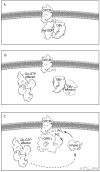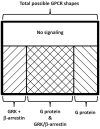A pharmacological primer of biased agonism
- PMID: 21476970
- PMCID: PMC3182416
- DOI: 10.2174/187153011795564179
A pharmacological primer of biased agonism
Abstract
Biased agonism is one of the fastest growing topics in G protein-coupled receptor pharmacology; moreover, biased agonists are used in the clinic today: carvedilol (Coreg®) is a biased agonist of beta-adrenergic receptors. However, there is a general lack of understanding of biased agonism when compared to traditional pharmacological terminology. Therefore, this review is designed to provide a basic introduction to classical pharmacology as well as G protein-coupled receptor signal transduction in order to clearly explain biased agonism for the non-scientist clinician and pharmacist. Special emphasis is placed on biased agonists of the beta-adrenergic receptors, as these drugs are highly prescribed, and a hypothetical scenario based on current clinical practices and proposed mechanisms for treating disease is discussed in order to demonstrate the need for a more thorough understanding of biased agonism in clinical settings. Since biased agonism provides a novel mechanism for treating disease, greater emphasis is being placed to develop biased agonists; therefore, it is important for biased agonism to be understood in equal measure of traditional pharmacological concepts. This review, along with many others, can be used to teach the basic concepts of biased agonism, and this review also serves to introduce the subsequent reviews that examine, in more depth, the relevance of biased agonism towards the angiotensin type 1 receptor, parathyroid hormone receptor, and natural biased ligands towards chemokine receptors.
Figures



Similar articles
-
Emerging structural insights into biased GPCR signaling.Trends Biochem Sci. 2014 Dec;39(12):594-602. doi: 10.1016/j.tibs.2014.10.001. Epub 2014 Nov 4. Trends Biochem Sci. 2014. PMID: 25458114 Review.
-
G protein stoichiometry dictates biased agonism through distinct receptor-G protein partitioning.Sci Rep. 2017 Aug 11;7(1):7885. doi: 10.1038/s41598-017-07392-5. Sci Rep. 2017. PMID: 28801617 Free PMC article.
-
Beta-arrestin biased agonism/antagonism at cardiovascular seven transmembrane-spanning receptors.Curr Pharm Des. 2012;18(2):192-8. doi: 10.2174/138161212799040475. Curr Pharm Des. 2012. PMID: 22229558 Review.
-
[G-protein-coupled receptors plasticity and signalling].Med Sci (Paris). 2012 Oct;28(10):883-5. doi: 10.1051/medsci/20122810018. Epub 2012 Oct 12. Med Sci (Paris). 2012. PMID: 23067421 Review. French.
-
G Protein-coupled Receptor Biased Agonism.J Cardiovasc Pharmacol. 2016 Mar;67(3):193-202. doi: 10.1097/FJC.0000000000000356. J Cardiovasc Pharmacol. 2016. PMID: 26751266 Free PMC article. Review.
Cited by
-
The influence of the way of regression on the results obtained by the receptorial responsiveness method (RRM), a procedure to estimate a change in the concentration of a pharmacological agonist near the receptor.Front Pharmacol. 2024 May 2;15:1375955. doi: 10.3389/fphar.2024.1375955. eCollection 2024. Front Pharmacol. 2024. PMID: 38756379 Free PMC article.
-
Prevention of skin carcinogenesis by the β-blocker carvedilol.Cancer Prev Res (Phila). 2015 Jan;8(1):27-36. doi: 10.1158/1940-6207.CAPR-14-0193. Epub 2014 Nov 3. Cancer Prev Res (Phila). 2015. PMID: 25367979 Free PMC article.
-
New Insights into the Structure and Function of Class B1 GPCRs.Endocr Rev. 2023 May 8;44(3):492-517. doi: 10.1210/endrev/bnac033. Endocr Rev. 2023. PMID: 36546772 Free PMC article.
-
Synergistic, multi-level understanding of psychedelics: three systematic reviews and meta-analyses of their pharmacology, neuroimaging and phenomenology.Transl Psychiatry. 2024 Dec 4;14(1):485. doi: 10.1038/s41398-024-03187-1. Transl Psychiatry. 2024. PMID: 39632810 Free PMC article.
-
The Science Behind G Protein-Coupled Receptors (GPCRs) and Their Accurate Visual Representation in Scientific Research.J Biocommun. 2017 May 4;41(1):e6. doi: 10.5210/jbc.v41i1.7309. eCollection 2017. J Biocommun. 2017. PMID: 36405408 Free PMC article.
References
-
- Kenakin TP. Quantitation in receptor pharmacology. Receptors. Channels. 2001;7:371–385. - PubMed
-
- Kenakin T. Inverse, protean, and ligand-selective agonism: matters of receptor conformation. FASEB J. 2001;15:598–611. - PubMed
-
- Kenakin T. Principles: receptor theory in pharmacology. Trends Pharmacol. Sci. 2004;25:186–192. - PubMed
-
- Kenakin T. Quantifying Biological Activity in Chemical Terms: A Pharmacology Primer to Describe Drug Effect. ACS Chem. Biol. 2009;4:249–260. - PubMed
Publication types
MeSH terms
Substances
LinkOut - more resources
Full Text Sources
Other Literature Sources

